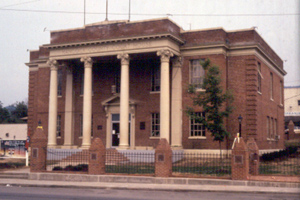
Hancock County
One of the earliest settlement areas in Tennessee is Hancock County. In a 1673 letter to John Richard of London, Abraham Wood reported James Needham and Gabriel Arthur’s journey into the area: “Eight dayes jorny down this river lives a white people which have long beards and whiskers and weares clothing, and on some ye other rivers lives a hairey people.” In 1784 John Sevier recorded in his journal that his party encountered white men in the same region and that they had been living there for some time. The word used to describe these people was “Melungeon,” initially thought to be derived from the French word “melange,” meaning mixture (as in mixed breed). The Melungeons spoke broken English and possessed English surnames but claimed to be Portuguese. Despite their insistence on their origins, the Scots-Irish settlers declared them “persons of color” and quickly confiscated their land. Denied access to legal recourse, education, or other advantages of citizenship, the Melungeons withdrew to the most isolated, least desirable mountain locales. Today, thousands of Appalachian people trace their ancestry to the Melungeons. The names most frequently associated with the Melungeons are Collins, Mullins, Goins, Gibson, Denham, Bowlin, and Sexton.
As Anglo-Europeans arrived in the area, the first settlers included Joseph Lamb, Jonas Lockmiller, John Ray, Enos Matthais, William McCully, and Daniel Slavins. The first settlers were joined by families with the following surnames: Greene, Purkey, Bray, Cantwell, Trent, Mitchell, Amis, Boulden, Anderson, Bryant, Campbell, McGhee, Mills, Ramsey, Winkler, Wilder, Jarvis, and Wallen. The earliest ministers were John Givens, Moses Williams, and Zachariah Seal. Initial settlement occurred in the area surrounding Greasy Rock, a large stone that protruded into a creek that ran into the Clinch River. The rock acquired its name because it was used by hunters to clean game.
At one time, Hancock County was part of Hawkins County, North Carolina, which later became Hawkins County, Tennessee. During the brief rule of the State of Franklin, Hancock was part of Spencer County. The creation of Hancock County in Tennessee was a complicated process. The 1844 act creating the county from parts of Hawkins and Claiborne Counties violated some provisions of the state constitution. A second act passed in 1846, and commissioners were appointed to organize the county and fix boundary lines. When some Hawkins County residents filed a bill enjoining commissioners from further action, all county business was suspended from 1846 to 1848, when the Tennessee Supreme Court ruled in favor of Hancock County. W. H. Sneed, a Knoxville attorney, represented Hancock County in the court action, and commissioners named the new county seat (at the site of Greasy Rock) Sneedville in his honor. The county name honored John Hancock, the Revolutionary War patriot. The first court was held at the house of Alexander Campbell and afterward at the old Union Church until 1850, when a small brick courthouse was built.
Hancock County has been the home of many men and women of character and ability. Among them are Ben Testerman, a Knoxville lawyer; W. T. Testerman, a member of the State Highway Commission; Judge H. Tyler Campbell; Hon. Alonzo Tyler; Judge W. T. Coleman, Judge A. T. Bowen; Colonel Grant Trent; Hon. Lewis Cass Jarvis; Hon. Alfred Tylor Drinnon, a legislator and attorney; and Burkett Wallen, superintendent of Rogersville schools. The grandparents of U.S. Senator Mark Hatfield moved from Hancock County to Oregon. Governor Clyde Pearson of Virginia was born in Hancock County. Hancock native Alex Stewart, master cooper and world-renowned Appalachian artisan, received the National Heritage Award at the Smithsonian Institution in Washington, D.C. At the time he received the award, Stewart was the only Tennessean who had been so honored.
Bluegrass singer and musician Jimmy Martin calls Hancock home and wrote a popular song about the county. Martin became a major star during his years as part of Bill Monroe and the Bluegrass Boys. Critics conclude that the duets of Martin and Monroe are among the true classics of bluegrass music. Martin left Monroe’s group in 1954 and struck out on his own, eventually forming his own influential band, the Sunny Mountain Boys, and recording for Decca Records. He expanded his popularity in the early 1970s when he performed on the Will the Circle Be Unbroken album by the Nitty Gritty Dirt Band. Martin was elected to the International Bluegrass Music Association Hall of Honor in 1995.
Sneedville, with a population of approximately 1,400, is the only incorporated town in the county. WSJK-TV, Channel 2, at Sneedville was the first state-owned public television station to sign on the air in Tennessee. Other communities in the county include Mulberry Gap, Kyles Ford, Treadway, and Vardy. At one time Hancock County had at least fifty-seven post offices, but today most mail is delivered through Sneedville.
Hancock County reported a 2000 population of 6,786 in 230 square miles. Traditionally, its economy has been based on agriculture and small businesses. In the 1950s zinc was discovered at Treadway. Mining operations continued until 1971, and at its peak, the mine employed more than 220 men. Present industries include a furniture factory, a laminated desktop factory, a roof truss factory, an electric motor plant, a concrete plant, and a wholesale craft manufacturer. A number of family-owned businesses operate alongside modern franchise establishments. The county has two banks with combined assets of over $112 million.
The county’s labor force numbers 3,120, and in 1991 unemployment stood at 5.1 percent. Currently, natural gas and oil wells are being developed, and gas lines are under construction. The county is also developing an industrial park on the Clinch River. State Highway 31 into Sneedville from U.S. 11W has been widened and straightened, and a new bridge across the Clinch River had been opened.



